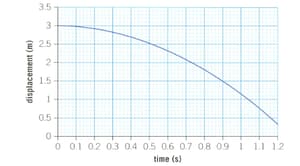On earth, the acceleration of an object in free fall is . How fast would an object be travelling after of free fall if it started from rest?

Important Questions on Movement
Set up a ramp that a ball bearing or marble can roll down. The ramp can be made of a half-pipe such as a length of guttering, or with something that has a square profile such as electrical cable trunking. The ramp should be about long.
Release the ball bearing or marble from the rest at from the end of the ramp. Let it roll to the bottom and record the time how long it takes with a stopwatch.
• Repeat this from from the end, then in increment.
In this experiment identify one control variable.
Set up a ramp that a ball bearing or marble can roll down. The ramp can be made of a half-pipe such as a length of guttering, or with something that has a square profile such as electrical cable trunking. The ramp should be about long.
Release the ball bearing or marble from the rest at from the end of the ramp. Let it roll to the bottom and time how long it takes with a stopwatch.
• Repeat this from from the end, then in increment.
Plot a distance-time graph to show the ball's motion (plot time on the x-axis). The average speed of the ball over each distanced can be found using the equation: Assuming that the ball is accelerating at a constant rate, the final speed of the ball at the end of the ramp is twice this:
Set up a ramp that a ball bearing or marble can roll down. The ramp can be made of a half-pipe such as a length of guttering, or with something that has a square profile such as electrical cable trunking. The ramp should be about long.
Release the ball bearing or marble from the rest at from the end of the ramp. Let it roll to the bottom and record the time how long it takes with a stopwatch.
• Repeat this from from the end, then in increment.
Plot a distance-time graph to show the ball's motion (plot time on the x-axis). The average speed of the ball over each distanced can be found using the equation: Assuming that the ball is accelerating at a constant rate, the final speed of the ball at the end of the ramp is twice this:
Set up a ramp that a ball bearing or marble can roll down. The ramp can be made of a half-pipe such as a length of guttering, or with something that has a square profile such as electrical cable trunking. The ramp should be about long.
Release the ball bearing or marble from the rest at from the end of the ramp. Let it roll to the bottom and time how long it takes with a stopwatch.
• Repeat this from from the end, then in increment.
Plot a velocity-time graph for the ball's motion (also plot time on the x-axis).
Set up a ramp that a ball bearing or marble can roll down. The ramp can be made of a half-pipe such as a length of guttering, or with something that has a square profile such as electrical cable trunking. The ramp should be about long.
Release the ball bearing or marble from the rest at from the end of the ramp. Let it roll to the bottom and time how long it takes with a stopwatch.
• Repeat this from from the end, then in Increment.
Plot a velocity-time graph for the ball's motion (also plot time on the x-axis).
Use this graph to find the acceleration of the ball.
Here is the displacement -time graph for an object in free fall on the surface of Mars:
 .
.
How can you tell that the object was dropped from rest.
